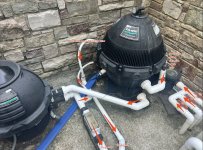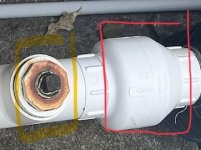However, I’d like to confirm something. When we talk about blowing water through the impeller side and the suction side, are we referring to removing the round clear cover and basket from the pump housing and then connecting the cyclone to either the left side (impeller) or the right side hole(suction)? I’m asking because most of the videos I’ve watched show people blowing out water from the drain plug on the pump housing.
Yes. The side closest to your skimmer/drain valves is the suction side. The front port would be the impeller and where you can blow the return side.
Drain all the equipment on the pad (pump, filter, heater) and reseal all drain ports. This is less water you have to push through the system.
Start on the suction side close all but 1 skimmer valve. Blow that skimmer until very little or no mist is blowing out of it. Close that valve and move to the next skimmer and blow it until very little or no mist is blowing out. Close that valve. Open the main drain and blow it….you will see a lot of air coming up from the drain. After a minute or two, close the valve while the cyclone is still blowing to air lock it.
Pump or pour a couple gallons of antifreeze in each skimmer pipe. I usually open the skimmer valve to let the AF flow easily then close the valve. (I use a pump but it’s not necessary). Seal the skimmer with a gizmo or plugs. Then pour AF in each skimmer body to fill it. If you use gizmos your done there. If you use plugs, put an empty but capped AF bottle in the skimmer body to absorb any freeze movement. You can weight the bottle with some gravel or crush up another empty AF bottle and use it as a wedge to hold the floating bottle in the middle of the skimmer body.
Move to the return side. Plug all but one return farthest from the pad. Start the cyclone and let it blow. When all the water has evacuated that return, unplug the next closer return, and plug the farther one. Let the cyclone blow the entire time. Once this return is dry, unplug the next closest and plug the previous one. Keep repeating until all returns are dry. For good measure after the closest return is dry, I go back to the farthest and unplug it, plug the closest and let it blow a little more.
3. Once the pipes are clear of water, I noticed from the attached photo that there’s no valve on the return line and the robot line. My concern is, when I remove the drain plugs from the heater, pool robot, etc., the air in the pipes is going to escape, causing water to backflow into the main and robot lines? Could this be a problem?
If you keep the cyclone blowing the whole time in the way I described above it won’t be a problem. That line is its own independent line and the pressure from the cyclone will keep any water at bay until it’s blown out.
For good measure once all the returns are dry, you can plug all the returns and open the heater drain and blow it. Then the filter drain. Remove all drain plugs from all equipment and leave them open.
At this point I will pump a couple of gallons of antifreeze in each return pipe at the pool and plug them. You can also gravity pour with a funnel, but it’s slightly less effective than using a pump with a bladder.
On the water fall pump, it would be similar but you’d blow the drain from the port behind the check valve and close its valve while the cyclone is blowing. Blow the fall itself from the impeller side. I see no good way to inject antifreeze into it, so just pull the pump plugs and put the lid back on.
What is your filter setup? Carts with a drain valve with the lay flat hose attached to the drain?








